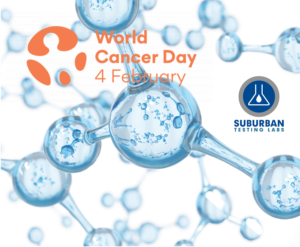World Cancer Day 2020
 February 4th marks World Cancer Day. Cancer is the second leading cause of death worldwide with 9.6 million people dying from cancer each year – this number is predicted to almost double by 2030*. One of the key ways to help reduce public risk is Government action and accountability. The EPA’s Brownfields Program and the Safe Drinking Water Act are two ways our government does just that.
February 4th marks World Cancer Day. Cancer is the second leading cause of death worldwide with 9.6 million people dying from cancer each year – this number is predicted to almost double by 2030*. One of the key ways to help reduce public risk is Government action and accountability. The EPA’s Brownfields Program and the Safe Drinking Water Act are two ways our government does just that.
What are some key cancer-causing contaminants we test for in our lab to support these programs? And what are the health effects? In this issue, we dive into some of these important cancer-causing contaminants.
Brownfield and Land Revitalization
Assessing contamination potential at Brownfields is critical to ensuring sites can be reused to benefit our communities. Over the past year we’ve performed more than 70,000 analyses for environmental consultants and facilities that responsibly dispose of harmful waste.
Contaminants often found at Brownfield sites include Lead, and Volatile Organic Compounds (VOCs). Human exposure pathways are breathing dust or soil particles, consumption of contaminated water or food, and skin contact with contaminated dust and soil particles.
Lead
Sources of Lead contamination are usually mining, fuel, paint, inks, piping, battery and ammunition production. In addition to causing cancer, Lead exposure can also cause damage to your brain, nerves, organs and bones.
Our lab has performs analyses for Lead using various methods, including EPA 200.7 and SW 846 6010/6020 using Inductively Coupled Plasma (ICP) technology. Methods used depend on sample characteristics and reporting limit requirements.
Volatile Organic Compounds (VOCs)
VOCs usually originate from industry and commercial product solvents, degreasers, paint strippers, and dry cleaning operations. In addition to causing various types of cancers, VOC exposure can also cause eye irritation, nausea, and damage to your kidney, liver and nervous systems.
Over the past year, our chemists have seen more than 11,000 VOC analyses pass through our laboratory via various methods, including EPA 624 and SW 846 8260. These tests are performed using state-of-the art Gas Chromatography / Mass Spectometry (GC/MS) technology.
Safe Drinking Water Act Analysis
Approximately 150,000 public water systems provide drinking water to Americans, and we perform high volumes of drinking water testing required of public water suppliers in Pennsylvania, New Jersey, Maryland and Delaware. Over the past year we’ve performed over 83,000 analyses in support of SDWA testing requirements. Two examples of the many cancer-causing contaminants we test for are Arsenic and Nitrate.
Arsenic
Arsenic is considered an Inorganic Contaminant (IOC) and EPA adopted a more stringent limit of 10 parts per billion (ppb) in 2001, down from the previous 50 ppb limit. It comes from erosion of natural deposits, runoff from orchards, run off from glass and electronic production wastes. It causes cancer of the bladder, lungs and skin.
Analyses for Arsenic in drinking water is performed via method EPA 200.8, which is analysis by Inductively Coupled Plasma – Mass Spectrometry (ICP-MS). We can analyze for many other trace metals using this method, such as Lead and Copper. Our standard reporting limit for Arsenic under 200.8 is .001 parts per million.
Nitrate
Second only to Total Coliform and E.Coli, Nitrate is a contaminant that requires frequent monitoring. Increased risks of colon, kidney, and stomach cancer were observed among those with higher ingestion of water nitrate and higher meat intake compared with low intakes of both
Nitrate contamination often originates from runnoff from fertilizer use, leaking from septic tanks, sewage, erosion of natural deposits.
We have multiple ways of analyzing Nitrate, including method EPA 300.0 using Ion Chromatography in our Inorganic Chemistry department. The Maximum Contaminant Level set by EPA is 10 ppm, and we routinely analyze down to the 1 ppm level.
Drinking water from private ground water wells is not regulated or tested for, unless the homeowner independently elects to do so.
